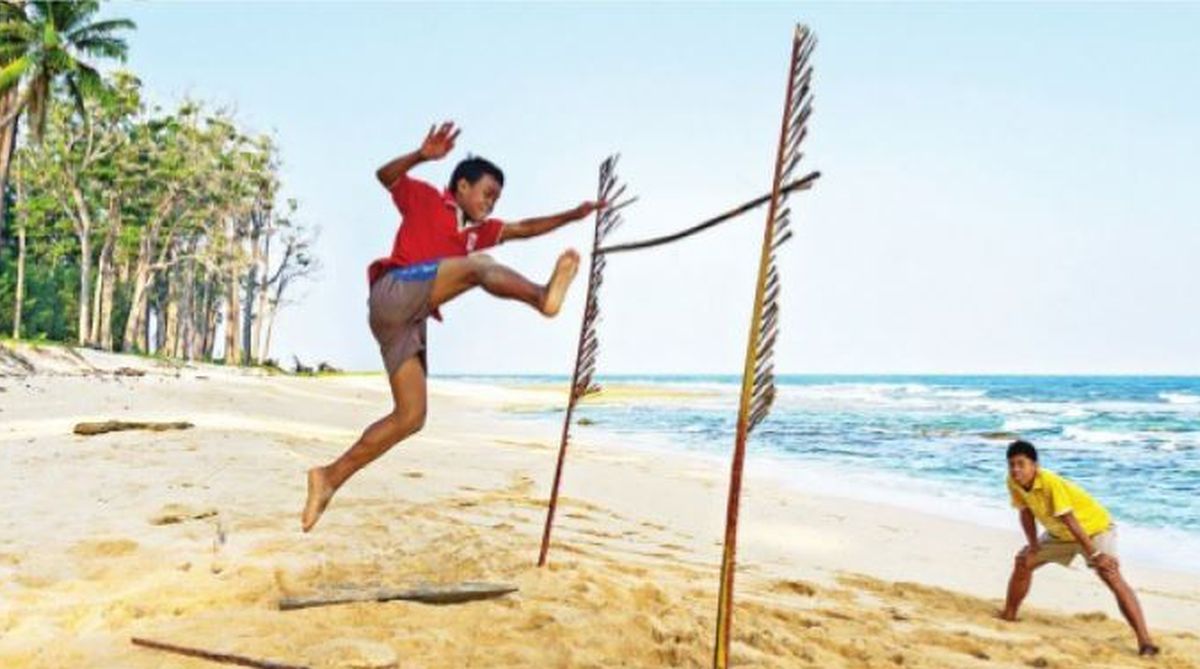It had been quite a long time since I joined my office at Little Andaman, an undulating landmass elevated from the azure ocean, but I hardly got to visit the native habitats, the Onges, as it was out of bounds to outsiders.
Then a friend from the administration called me to accompany him to the area during a weekend. Unbelievable though it seemed to me, there we were, following the roller coaster alley to reach a creek. A motorised dinghi, roped on a drooped trunk, bobbed on the water lit up by the rays of the late morning sun.
Velayu, an ebony-skinned muscular boy, invited us on his boat. A settler from Sri Lanka, his parents had been allotted a few acres of arable land on this island and coming as they did from similar terrain, they seemed quite at home in the lush green archipelago.
As we embarked on his tiny boat, Velayu revved up the engine and in moments, it steered down the meandering creek. At every bend, we felt we were turning pages from Rudyard Kipling’s works. As we passed through the canopied tunnel of towering trees, parakeets fluttered their wings and crocodiles stared stoically at us from the edge of the moss green water.
Soon the thunderous sound of the sea overtook the noise of our engine, and we realised we are approaching the open sea, the most dangerous part of the route to our destination — Dugong Creek. We clutched tightly to the edge of the vessel as Velayu dexterously steered it through the mighty waves on either side of us. It tossed our boat high in the air several times before slamming it back on the choppy waters. Soon we were in mid-sea, leaving the green suggestion to our left. Far away towards the western horizon, appeared the misty outline of Dugong Creek.
As we approached, an outhouse of the settlement took shape against the thicket of casuarinas and coconut palms. We were amazed to see two Onge men maneuvering their tiny outrigger off the shore for fishing. Tucked away in the backdrop was a cluster of wooden thatched huts hemmed in by luxuriant foliages. A gawky Onge boy rushed to the jetty to carry our satchels. The rows of neat cottages marked as “Guest House”, “Office”, “Medical”, “Godown” et al had all the trappings to support modern living including a panel for solar lights.
A sprightly Onge boy shimmied up a tall coconut tree, plucked a bunch of giant fruits and grounded in an amazingly acrobatic swoop. We quenched our thirst with sweet water, overwhelmed with their hospitality. Soon, a social worker introduced us to the Onge Chief, Mr Thambolai, with whom I intended to meet. He was a short, glisteningly dark, thickly-built old man wearing a loin cloth. His eyes sparkled, as he greeted us in chaste Hindi, “Namaste”, I was overawed.
We were amazed to see how some ladies weaving mats and fishing cages from pandanus leaves. Onges are dwindling alarmingly. The Aadim Janajati Vikas Samiti, an agency of Andaman and Nicobar Administration, looks after them. Rice, wheat, tea and potatoes are supplied to the people, who otherwise live on tubers, wild-fruits, boars, fishes and turtles from the forests and sea.
A kind of barter system prevails there. They collect essentials from the store in exchange for coconuts, honey, resins an pandanus gathered by them. Community shacks called Berrari — a kind of inverse honeycomb made of leaves — have now been replaced with stilted wooden units called Kerrali that dot the clearings.
As darkness enveloped the expanse, the shrill cry of cicadas, croaking of frogs rent the air. We had a simple but tasty dinner at the guest house and before going to bed, we learnt a harrowing tale from the instructor, who trained crafts from shells, timbers et al. He narrated in a hushed voice, “Despite our best efforts, some feel, it is just a matter of time before they bid the world a final goodbye.” The seed of extinction, however, is ingrained in their social customs in which the Administration do not interfere. While we pondered, he quipped “Their system, inter alia ordains, ‘An aged widower gets first preference to marry a girl’, that’s why you see so few children.”
Next morning, we took leave and as our boat moved homewards, the shore receded before our wistful gazes. We were saddened by the thought that perhaps in our next visit to Dugong Creek, there will be even fewer Onge left to welcome us.











